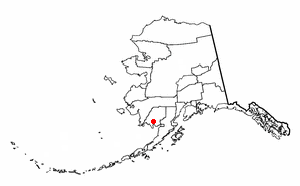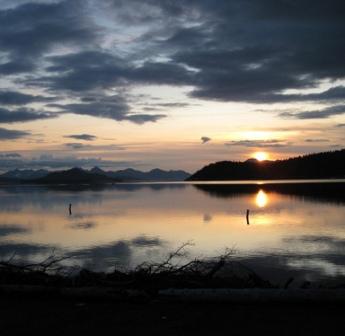|
Alaska has about 3,197 officially
named natural lakes, out of over 3,000,000 unnamed
natural lakes. 86,051 square miles of Alaska are covered
by water. The largest, Lake Iliamna, encompasses over
1,000 square miles. Many of Alaska's lakes are only
reachable by air or boat. Lakes that are easily
accessible are used for recreation such as boating,
fishing, and swimming.
Aleknagik Lake is a lake in the U.S. state of Alaska. It
is 32 km (20 mi) long by 26 km (16 mi) wide. The village
of Aleknagik is on its southeast shore. Aleknagik is a
Yupik word meaning "wrong way home". Yupiks returning to
their homes along the Nushagak River would sometimes
become lost in the fog and be swept up the Wood River to
Aleknagik Lake by the tide. Fog and low clouds are
common during July and August and may preclude access.
Wood River and Aleknagik Lake
have been used historically as summer fish camps. The
lake and river are ice-free from June through
mid-November.
Aleknagik is the only regional village with a road
link to Dillingham, a 25-mile (40 km) road which
connects the south shore. The "New Aleknagik" airport is
a State-owned 2,070' long by 90' wide gravel airstrip
located on the north shore, and regular flights are
scheduled through Dillingham. The north shore of the
lake is not road accessible; residents use skiffs to
travel to town on the south shore. Moody's Aleknagik
Seaplane Base, also on the north shore, accommodates
float planes. There are two additional airstrips, the
public Tripod Airport, a 1,250' turf-gravel airstrip
located 2 miles (3.2 km) southeast of Aleknagik, and the
Adventist Mission School Airport, a 1,200' gravel/dirt
airstrip with a crosswind runway. The State owns and
operates a 100' dock on the north shore of Aleknagik
Lake. A breakwater, barge landing, boat launch ramp and
boat lift are available on the north shore. Vehicles,
skiffs, ATVs and snow machines are the most frequent
means of local transportation.
Lake Aleknagik SRS is the Gateway to Wood-Tikchik State
Parks. The site provides the dpeparture point for
visitors to Lake Aleknagik and Wood-Tikchik State Park.
Limited accommodations are available for boat and float
planes. Gasoline and aviation fuel is available in
Aleknagik. The Wood-Tikchik Park ranger station is
located here.
For hundreds of years the village of Aleknagik was
the hub of trade and culture for the Alaska native
peoples who lived throughout the Bristol Bay region. The
ideal setting along the shores of Lake Aleknagik and the
safe haven this location provided from the harsh winters
of Southwest Alaska, proved to be the reason many of the
regions natives made Aleknagik their winter home. Fur
was the main item of commerce along with dried fish,
berries, and hides from the previous summers harvest.
Lessons learned from fishing and hunting expeditions
were shared, creating strong ties amongst the people who
came here.
The longer days of spring and the break up of ice
signaled the people to leave the village to hunt and
gather food for their return to Aleknagik in the fall
and winter. The lives of the people here were ones of
complex simplicity. Survival of the tribe depended on
their skills as hunters, fishermen, and craftsmen.There
was little room for error in this land. The terrain in
which they traveled was laden with hazards, and the weak
or unwise didn’t last very long. This land also provided
for its people with abundant fish, game, fowl and
vegetation.
In 1897 the first barrels of salted Salmon aboard the
schooner Neptune arrive at the ports of the west coast.
Life would never be the same for the natives of
Aleknagik. The traditional ways of survival would give
way to “commercial fishing” as the villagers were forced
to yield to the demands of the canneries and their
influence. Fishing quickly replaced trapping as the
major source of income among the people of the region.
Lake Aleknagik is the southern most in a string of lakes
that form the Wood River Lakes system. With road access
to Dillingham, the village of Aleknagik on the lake’s
southern end functions as the gateway toWood-Tikchik
State Park. This is the largest state park in the United
States and one of Alaska’s premier sport fishing,
kayaking and canoeing areas.
|





